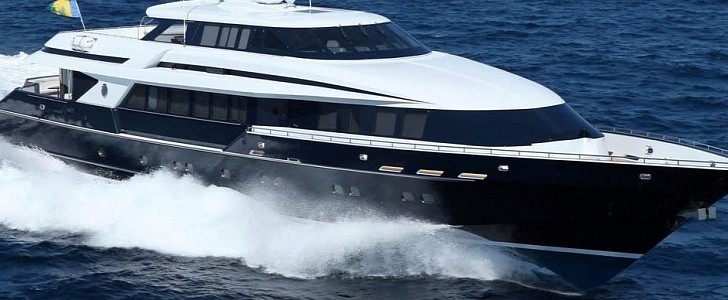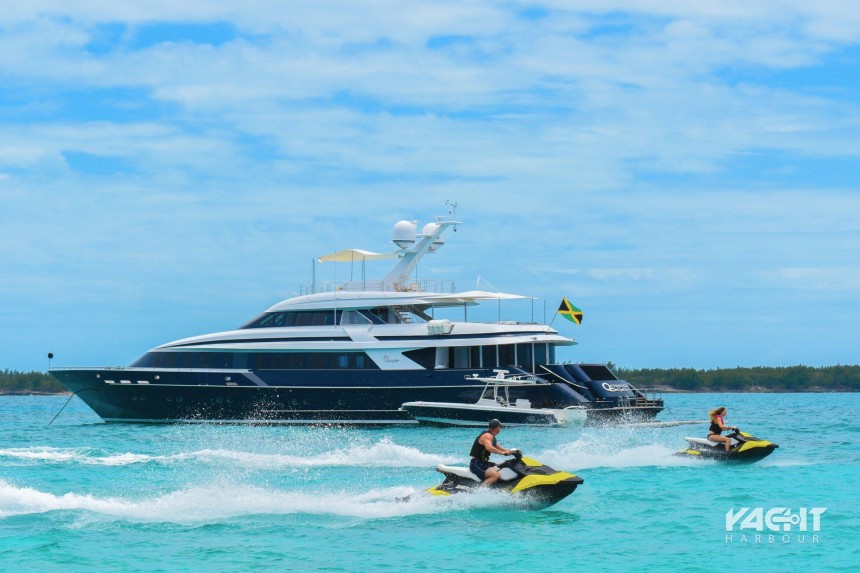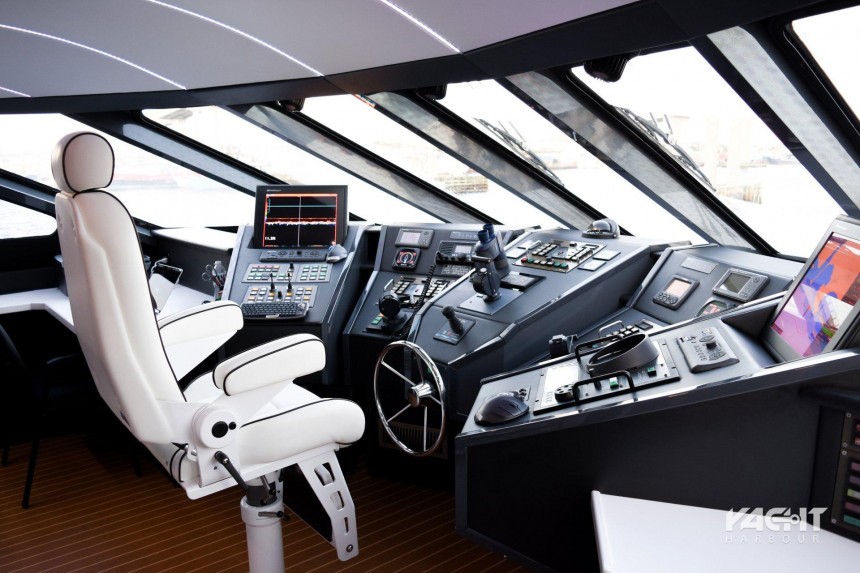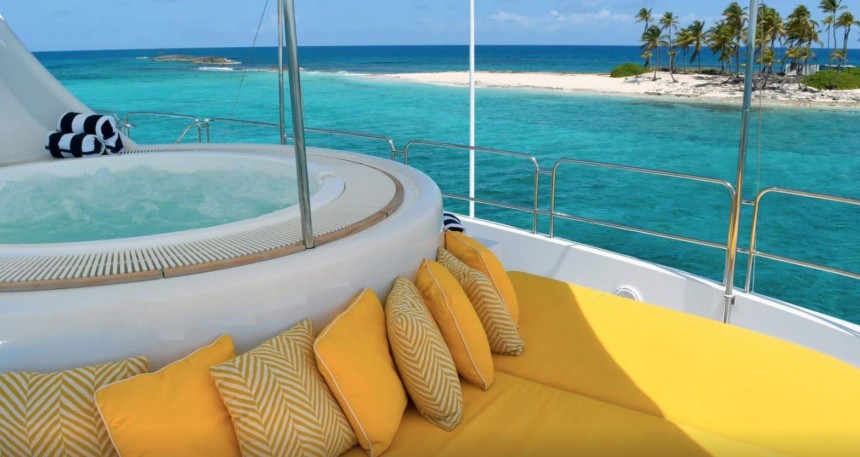These days, it’s not impossible to find someone to build you a luxury yacht, or a superyacht for that matter, with the performance of a racer. You need to be rich, but that’s pretty much the only impediment. When Octopussy was delivered, the feat was considered impossible across the board.
This is the story of Octopussy, the first superyacht to become the world’s fastest by breaking the 50-knot (57.5 mph / 92.6 kph) barrier. Delivered to the owner in 1988, with all the specifications included in the briefing, it is one of the most iconic and historically relevant naval builds of modern times. The fact that it’s still around, albeit no longer up to par with its prior performance, only adds more intrigue to the story.
Octopussy was named this way because its owner, and the man largely credited for its existence, because it was his dream for the world record that fueled the project – was a huge James Bond fan. John Staluppi is an American businessman and car guy, a passionate collector and founder of the Atlantic Auto Group, a huge 007 fan, and an avid seafarer. He’s a multi-millionaire, too, just to be sure. So far, he’s owned 21 boats of varying sizes, but none of them as special as Octopussy.
Octopussy was Staluppi’s second boat and its most daring project. At the time he came up with the idea to build the world’s fastest superyacht, in the mid-’80s, things in the industry were not exactly thrilling: shipyards were focusing on blocky designs that would fit in as many amenities as possible. Staluppi believed he could have a superyacht, with all the trappings of the A-list life and performance of the kind he’d only get in his racers. A breakneck fast superyacht.
Since money was no issue, the only problem for Staluppi was that no one else believed such a combination was possible.
Before he even found a designer and a shipyard for the project, Staluppi went ahead and bought the engines for it: three MTU 16V 396 TB94 engines of 2,520 kW and 3,500 hp each and three Kamewa waterjets. In a move that was described then as unheard of, he had the propulsion system and wanted to build a boat around it; that approach remains highly unlikely to this day.
This was when Frank Mulder of Mulder Design came into the picture. Mulder told Staluppi that he would try to see if such a boat could be built and if, at the end of six weeks, it would prove possible, he’d do it free of charge. Staluppi was thrilled, but his excitement would only grow after the deadline when Mulder informed him that tank testing had shown such a boat could, indeed, be constructed. If they found a shipyard willing to take the challenge.
At the time, Heesen Yachts from the Netherlands was a smaller shipyard. It’d been in the business for just a few years, and while it delivered quality vessels, it was yet to break through on an international scale. On a dare, Frans Heesen agreed to build this impossible boat; just as Staluppi was starting to lose hope that they’d ever find a builder since they’d been looking everywhere for over a year.
Because this was the kind of project never attempted before, it came with high risks for everyone involved. Staluppi insisted on penalty clauses in the contract to make sure he’d get the 50 knots promised: if the ship delivered under that, he’d be paid $100,000 for each knot missing; if it went under 48 knots, he could ask for his money back and refuse delivery.
In 1988, Octopussy was delivered. It marked a new era in naval design both for Heesen and the industry as a whole. Because of the focus on its expected performance, it was built with great attention to overall weight: with an aluminum hull and superstructure, it was built with the lightest materials available. Total length ended up at 142 feet (43.58 meters), and it came with super thin polyester panels, floors of multiplex and balsa wood, and the most “underdressed” interiors penned by Art Line and Joachim Kinder Yacht Design on the Mulder Design architecture.
Accommodation onboard was for 10 guests across five suites, and amenities included a jacuzzi, sun deck, swim platform, and generous lounge areas. Octopussy, for all the weight-shaving, was a proper superyacht that did not skimp on comfort or the level of luxury offered.
During the first round of sea trials, Octopussy was tracked by Maas Radar from Europoort and by Staluppi himself, using a police radar gun – and delivered an astounding 52 knots (59.8 mph / 96.3 kph), well above the contractual limit. Any other man would have probably settled for this record, but Staluppi believed the boat had even more in it with the right adjustments. After speaking with the team, including Heesen and Mulder, they cut off sections from the bottom of the hull, the boxes next to the waterjets, in a bid to make it even lighter. It was another risky move, but it paid off, as Octopussy gained another knot, hitting the official top speed – and world record – of 53.2 knots (61.2 mph / 98.5 kph).
In the years that have passed since, Octopussy has lost its hold on the title of world’s fastest. It has changed hands several times and has become a popular charter vessel, which means it’s been upgraded to accommodate more guests and includes more amenities, which, in turn, have added weight. Top speed has dwindled down to 15 knots (17.2 mph / 27.7 kph), which is still decent, but not for a heavyweight like this one.
In June this year, Octopussy was brought into Safe Harbor Lauderdale Marine Center in South Florida for a refit that will restore it to its former glory, down to the stellar performance. Mulder Design is involved in the refit, which is expected to be completed in 2023. Until then, let’s relive together the good ol’ days: here’s the Octopussy launch and a 2020 Heesen documentary on the build process.
Octopussy was named this way because its owner, and the man largely credited for its existence, because it was his dream for the world record that fueled the project – was a huge James Bond fan. John Staluppi is an American businessman and car guy, a passionate collector and founder of the Atlantic Auto Group, a huge 007 fan, and an avid seafarer. He’s a multi-millionaire, too, just to be sure. So far, he’s owned 21 boats of varying sizes, but none of them as special as Octopussy.
Octopussy was Staluppi’s second boat and its most daring project. At the time he came up with the idea to build the world’s fastest superyacht, in the mid-’80s, things in the industry were not exactly thrilling: shipyards were focusing on blocky designs that would fit in as many amenities as possible. Staluppi believed he could have a superyacht, with all the trappings of the A-list life and performance of the kind he’d only get in his racers. A breakneck fast superyacht.
Before he even found a designer and a shipyard for the project, Staluppi went ahead and bought the engines for it: three MTU 16V 396 TB94 engines of 2,520 kW and 3,500 hp each and three Kamewa waterjets. In a move that was described then as unheard of, he had the propulsion system and wanted to build a boat around it; that approach remains highly unlikely to this day.
This was when Frank Mulder of Mulder Design came into the picture. Mulder told Staluppi that he would try to see if such a boat could be built and if, at the end of six weeks, it would prove possible, he’d do it free of charge. Staluppi was thrilled, but his excitement would only grow after the deadline when Mulder informed him that tank testing had shown such a boat could, indeed, be constructed. If they found a shipyard willing to take the challenge.
At the time, Heesen Yachts from the Netherlands was a smaller shipyard. It’d been in the business for just a few years, and while it delivered quality vessels, it was yet to break through on an international scale. On a dare, Frans Heesen agreed to build this impossible boat; just as Staluppi was starting to lose hope that they’d ever find a builder since they’d been looking everywhere for over a year.
In 1988, Octopussy was delivered. It marked a new era in naval design both for Heesen and the industry as a whole. Because of the focus on its expected performance, it was built with great attention to overall weight: with an aluminum hull and superstructure, it was built with the lightest materials available. Total length ended up at 142 feet (43.58 meters), and it came with super thin polyester panels, floors of multiplex and balsa wood, and the most “underdressed” interiors penned by Art Line and Joachim Kinder Yacht Design on the Mulder Design architecture.
Accommodation onboard was for 10 guests across five suites, and amenities included a jacuzzi, sun deck, swim platform, and generous lounge areas. Octopussy, for all the weight-shaving, was a proper superyacht that did not skimp on comfort or the level of luxury offered.
During the first round of sea trials, Octopussy was tracked by Maas Radar from Europoort and by Staluppi himself, using a police radar gun – and delivered an astounding 52 knots (59.8 mph / 96.3 kph), well above the contractual limit. Any other man would have probably settled for this record, but Staluppi believed the boat had even more in it with the right adjustments. After speaking with the team, including Heesen and Mulder, they cut off sections from the bottom of the hull, the boxes next to the waterjets, in a bid to make it even lighter. It was another risky move, but it paid off, as Octopussy gained another knot, hitting the official top speed – and world record – of 53.2 knots (61.2 mph / 98.5 kph).
In June this year, Octopussy was brought into Safe Harbor Lauderdale Marine Center in South Florida for a refit that will restore it to its former glory, down to the stellar performance. Mulder Design is involved in the refit, which is expected to be completed in 2023. Until then, let’s relive together the good ol’ days: here’s the Octopussy launch and a 2020 Heesen documentary on the build process.


















